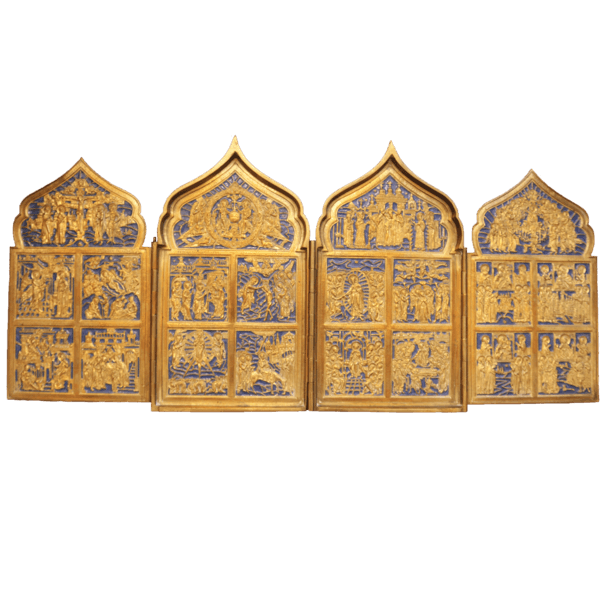A folding icon is a few icons that are located on foldable panels, usually two or three. These panels are connected by hinges. When folded, such an icon does not take up much space, but at the same time it contains, in fact, a small iconostasis.
Initially, folding icons were intended for praying during long journeys – and therefore they were called travel icons. In Russia, warriors often carried them with them to ask for divine protection before battles. That is why one of the most common images on ancient folding icons was that of Great Martyr Saint Pantaleon, revered as a healer and ‘unmercenary doctor’.
Most often in Russia there could be found folds with three icons, two panels of which covered the middle part. The form of the triptych symbolised the Royal Gates – a traditional component of the church iconostasis. When folded, such an icon became square. As a rule, on its cover was depicted the Golgotha cross.
In the centre of the triptych they often depicted the Saviour, on the right – the Mother of God, and on the left – St. Nicholas the Wonderworker. Triptych icons could be of different sizes: pectoral, pendant, kiot (stand) and others.
There were more complex, unusual folding icons. For example, those with four panels, like the one presented at the exposition. They were called ‘polyptychs’. And the folding icon ‘the Twelfth Great Feasts’ consisted of as many as 12 icons. This miniature iconostasis was not only taken on trips, but was also placed at home in the Red Corner.
The process of folding icon creation was quite laborious. First, they made the base and hinges. The icons were made of copper, bronze and wood: Karelian birch, linden or cypress. Next, the carver set to work. Finished folding icons were enamelled and decorated with precious stones. Especially valuable were folding icons decorated with enamel of different colours.
In 1722 a decree was issued prohibiting ‘the use of carved and cast icons in church and private houses’. At that time, the Old Believers, with whom there was an active struggle, practically monopolized copper casting. And copper folding icons, like the one displayed at the exposition of the museum, became increasingly rare.
Nevertheless, the Old Believers continued to illegally produce such icons. Over time, they became an independent movement in the art of past centuries.
Initially, folding icons were intended for praying during long journeys – and therefore they were called travel icons. In Russia, warriors often carried them with them to ask for divine protection before battles. That is why one of the most common images on ancient folding icons was that of Great Martyr Saint Pantaleon, revered as a healer and ‘unmercenary doctor’.
Most often in Russia there could be found folds with three icons, two panels of which covered the middle part. The form of the triptych symbolised the Royal Gates – a traditional component of the church iconostasis. When folded, such an icon became square. As a rule, on its cover was depicted the Golgotha cross.
In the centre of the triptych they often depicted the Saviour, on the right – the Mother of God, and on the left – St. Nicholas the Wonderworker. Triptych icons could be of different sizes: pectoral, pendant, kiot (stand) and others.
There were more complex, unusual folding icons. For example, those with four panels, like the one presented at the exposition. They were called ‘polyptychs’. And the folding icon ‘the Twelfth Great Feasts’ consisted of as many as 12 icons. This miniature iconostasis was not only taken on trips, but was also placed at home in the Red Corner.
The process of folding icon creation was quite laborious. First, they made the base and hinges. The icons were made of copper, bronze and wood: Karelian birch, linden or cypress. Next, the carver set to work. Finished folding icons were enamelled and decorated with precious stones. Especially valuable were folding icons decorated with enamel of different colours.
In 1722 a decree was issued prohibiting ‘the use of carved and cast icons in church and private houses’. At that time, the Old Believers, with whom there was an active struggle, practically monopolized copper casting. And copper folding icons, like the one displayed at the exposition of the museum, became increasingly rare.
Nevertheless, the Old Believers continued to illegally produce such icons. Over time, they became an independent movement in the art of past centuries.



